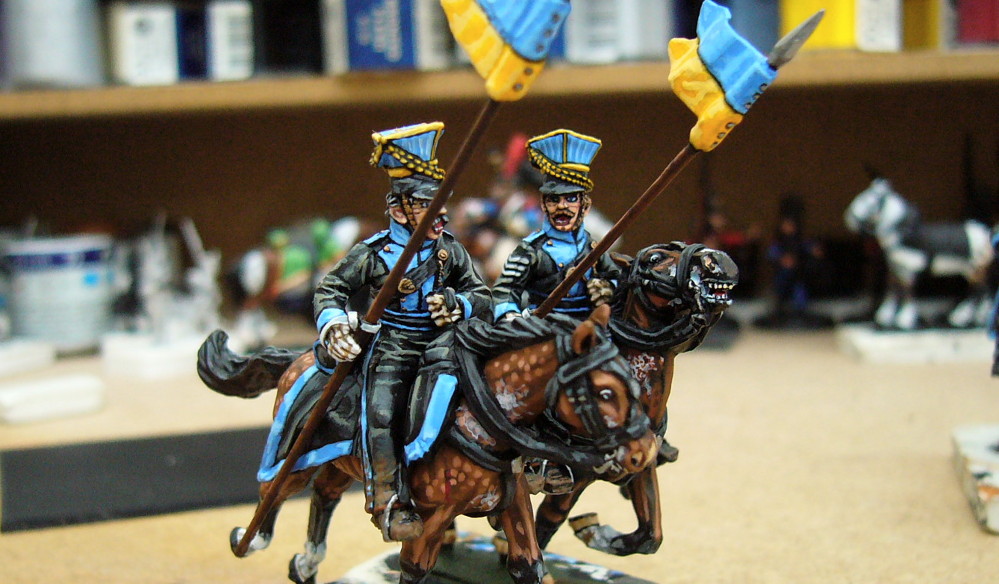
A couple of years ago Ed and I applied our mutual interest in the Lord of the Rings Strategy Battle Game to GMing a game for Millennium 8 in Austin, Texas. The game was successful and the players had a good time. The success prompted us to start planning for a bigger and better LotR:SBG game at Millennium 9. We plotted the scenario and even started buying figures. Until one day…
…Ed sent me a picture of a painted Perry Brothers’ Brunswick Uhlan. Well, that led me to the Perry web page and soon we were talking more and more about 28mm Napoleonics and less and less about LotR. Before long the plans for the LotR game were pitched overboard and Ed and I were assembling Napoleonic armies. His were French while mine were British and Brunswickers. We chose Le Petit Empereur (LPE), by Chipco, as our rules because the armies don’t require many figures and we both have played many LPE games over the years. While we preparing our armies for Millennium 9, we started talking about other rules that we would like to play.
…Ed sent me a picture of a painted Perry Brothers’ Brunswick Uhlan. Well, that led me to the Perry web page and soon we were talking more and more about 28mm Napoleonics and less and less about LotR. Before long the plans for the LotR game were pitched overboard and Ed and I were assembling Napoleonic armies. His were French while mine were British and Brunswickers. We chose Le Petit Empereur (LPE), by Chipco, as our rules because the armies don’t require many figures and we both have played many LPE games over the years. While we preparing our armies for Millennium 9, we started talking about other rules that we would like to play.
The game presented at Millennium 9 was a great success as reported by Ed on the Discussion Board at the The Miniatures Page. Some additional photos are available here and here.
We both expressed an interest in playing 28mm Napoleonics at a 1:30 figure to men ratio. This makes battalions of somewhere around twenty figures or so. Once we had the scale, we needed rules and so we bandied about ideas. My first impulse was to go back to my war gaming roots and adopt a The Sword and the Flame variant. TSATF is a game I know very well and I really like the mechanics. Ed had a pre-publication copy of Wellington’s Rules and sent it to me for review.
I must admit that I really liked the rules with the first read though. Wellington Rules captures the essence of two of the mechanics that I really like in TSATF. Those being movement allowance is a function of a base amount plus a die roll and the concept of stragglers degrading combat effectiveness. The third game mechanic that makes TSATF uniquely cinematic is the use of a standard deck of cards for initiative and casualty determination. Admittedly, the results of the card mechanics is a very cinematic game and isn’t well suited to the Napoleonic type of game in which we’re interested. Wellington Rules, however, has more deterministic command and control and casualty rules. Additionally, we feel it’s better to use a published set of rules at a convention as players will be able to obtain them if they so desire. Needless to say, it didn’t take us long to order the published version of the rules and pursue or planning in earnest.
So there you have it in a nutshell. That’s how we got from there to here. In upcoming posts, you, my dear reader, will be introduced to the big Napoleonic game Ed and I will be GMing at Millennium 10. We will be posting our progress in planning and assembling the armies. We will post reviews of the rules as we get some experience with them under our belt. So off we go into the fray…
Huzzah!
I must admit that I really liked the rules with the first read though. Wellington Rules captures the essence of two of the mechanics that I really like in TSATF. Those being movement allowance is a function of a base amount plus a die roll and the concept of stragglers degrading combat effectiveness. The third game mechanic that makes TSATF uniquely cinematic is the use of a standard deck of cards for initiative and casualty determination. Admittedly, the results of the card mechanics is a very cinematic game and isn’t well suited to the Napoleonic type of game in which we’re interested. Wellington Rules, however, has more deterministic command and control and casualty rules. Additionally, we feel it’s better to use a published set of rules at a convention as players will be able to obtain them if they so desire. Needless to say, it didn’t take us long to order the published version of the rules and pursue or planning in earnest.
So there you have it in a nutshell. That’s how we got from there to here. In upcoming posts, you, my dear reader, will be introduced to the big Napoleonic game Ed and I will be GMing at Millennium 10. We will be posting our progress in planning and assembling the armies. We will post reviews of the rules as we get some experience with them under our belt. So off we go into the fray…
Huzzah!


1 comment:
Well, Ed and you have a 'big' task ahead, and I can offer some meager forces if needed, a few "froggie" infantry,some "Brits" and even some quirky Allies. Not as pretty as the newer, "full breasted", boyz of Foundry, 1st Corps and such, but the lean, battle-hardened troops of Hinchliffe, Minifig and Elite! Whether "Vive le Emperour" or "For God, England, and Saint George", or even "Gott Mitt Uns" they will fight to the end!
Mark, the "black-hole" of wargaming lead!
Post a Comment